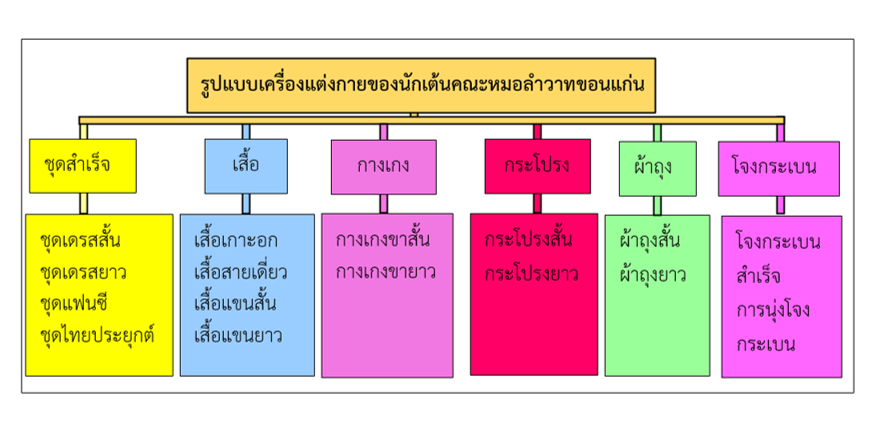THE COSTUME DESIGNSN FOR THE MORLAMWATKHONKAEN'S DANCERS
Main Article Content
Abstract
This research aimed to study Mor Lam Ward KhonKaen dancers' costume development as well as the dancers' costume design by using a qualitative research method. The data was collected through documents and field data of a sample group of 47 people, which included 9 experts, 18 practitioners, and 20 general people. Observation forms and interview forms were used as research instruments. The research results were presented by descriptive and analytical methods. data analysis was presented using the descriptive analysis approach.
The results of the study found that 1. Mor Lam Ward KhonKaen dancers' costume development from the past to the year 2019 can be divided into 3 periods, each of which has its development and invention transfer process including getting ideas from outside to combine all the time, such as the idea of modifying the production of costumes to respond to social phenomena and to stimulate stability and survival in accordance with the changing social trends in each era especially in a society that is constantly moving and there is a high competition in business 2. As for the costume design of the Khon Mor Lam Ward KhonKaen dancers, there is a paradigm in creating works through design concepts that are primarily in accordance with popular trends by replicating the dancers' costumes in various entertainment venues and media, integrating with the designer's creativity and experience under the concept of two primary groups: 1) a band that performs music. 2) Country and Mo Lam genres, which are separated into six categories based on costume style: 1) shirt, 2) skirt, 3) pants, 4) sarong, 5) loincloth, and 6) ready-made costume.
Article Details

This work is licensed under a Creative Commons Attribution-NonCommercial-NoDerivatives 4.0 International License.
References
ทวีเกียรติ ไชยยงยศ. (2538). สุนทรียะทางทัศนศิลป์โครงการตําราคณะศิลปกรรมศาสตร์ สถาบันราชภัฎสวนดุสิต ในโอกาสฉลองครบรอบ 60 ปี วิทยาลัยครูสวนดุสิต. พิมพ์ครั้งที่ 2. กรุงเทพมหานคร : สถาบันราชภัฎสวนดุสิต.
ธีรยุทธ์ มูลละออง. (2553). การศึกษาและพัฒนาการเครื่องแต่งกายไทยทรงดำเพื่อธุกิจชุมชน : กรณีศึกษาจังหวัดสุพรรบุรี. วิทยานิพนธ์ศิลปกรรมศาสตรมหาบัณฑิต สาขาวิชานวัตกรรมการออกแบบ. บัณฑิตวิทยาลัย : มหาวิทยาลัยศรีนครินทรวิโรฒ.
บรรจบ กำจัด. (2549). ศาสตร์แห่งสีเพื่อบำบัดโรคชีวจิต ปีที่ 9. สืบค้นเมื่อ 16 พฤศจิกายน 2564. จาก https://www.kkgcap.com/th/articles/97834
บุญจันทร์ เพชรเมืองเลย, สำเร็จ คำโมง. (2561). การวิเคราะห์วรรณกรรมลำเรื่องต่อกลอนทำนอง ขอนแก่น : กรณีศึกษา หมอลำอร่าม มุงคำภา. สืบค้นเมื่อ 27 มีนาคม 2564. จาก https://oer.learn.in.th/search_detail/result/107524
ประมวล พิมพ์เสน. (2546). หมอลำหมู่วาทขอนแก่น. พิมพ์ครั้งที่ 2. ขอนแก่น : ศูนย์วัฒนธรรมจังหวัดขอนแก่น โรงเรียนกัลยาณวัตร.
ปัทมาวดี ชาญสุวรรณ. (2542). พัฒนาการของหางเครื่องหมอลำหมู่วาทขอนแก่น. วิทยานิพนธ์ศิลปศาสตรมหาบัณฑิต สาขาวิชาไทยคดีศึกษา. บัณฑิตวิทยาลัย : มหาวิทยาลัยมหาสารคาม.
พรเทพ วีระพูล. (2535). การแสดงหางเครื่องหมอลำหมู่. วิทยานิพนธ์ศิลปศาสตร์มบัณฑิต สาขาวิชาไทยคดีศึกษา. บัณฑิตวิทยาลัย : มหาวิทยาลัยมหาสารคาม.
วิภาพร ฝ่ายเพีย. (2556). การสร้างสรรค์ฟ้อนพื้นบ้านอีสาน : กรณีศึกษาวิทยาลัยนาฏศิลปกาฬสินธุ์. วิทยานิพนธ์ศิลปศาสตรมหาบัณฑิต สาขาวิชาศิลปะการแสดง. บัณฑิตวิทยาลัย : มหาวิทยาลัยราชภัฏสวนสุนันทา.
วุฒิชัย ค้าทวี. (2559). พัฒนาการเครื่องแต่งกายยืนเครื่องละครสวนสุนันทา. วิทยานิพนธ์ศิลปะศาสตร มหาบัณฑิต สาขาวิชาศิลปะการแสดง. กรุงเทพมหานคร : มหาวิทยาลัยราชภัฏสวนสุนันทา.
สุรพล วิรุฬห์รักษ์. (2547). นาฏยศิลป์ปริทรรศน์. กรุงเทพมหานคร : ภาควิชานาฏศิลป์ คณะศิลปกรรมศาสตร์ จุฬาลงกรณ์มหาวิทยาลัย.
อดิศร เพียงเกษ. (2536). ศิลปินพื้นบ้าน (หมอลำ) ภาคตะวันออกเฉียงเหนือและการอบรมเยาวชนวัฒนธรรมของแก่น ปี 2536. ขอนแก่น : ขอนแก่นการพิมพ์.


